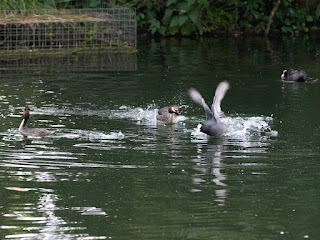The Grey Heron chicks in the fourth nest were already feeling the urge to wander, and fidgeting in the nest. The third one had climbed out and can be glimpsed for a moment in the leaves to the right.
The heron in the west nest is still standing there day after day. Although it seems to have a mate, it seems less and less likely that they're going to nest.
More Cormorants have arrived, and were ranged on the posts below.
A heron was fishing by the barrier around the Mute Swans' nest site east of the Lido. A Carrion Crow on the fence couldn't resist attacking it. It's not clear why herons and crows are such inveterate enemies.
Great Crested Grebes and Coots are also perennially hostile. A pair of Coots annoyed the grebes at the east end of the island and got chased off.
The grebes congratulated each other on their success.
The Coots' nest by the bridge has grown into a tall structure. One parent turned over the eggs to keep them warmed, the other arrived with a leaf. Coots share nest duties, so you can't tell which is which.
The nest at the corner of the reed bed by the Serpentine outflow has survived another day without being hit by a pedalo.
The Mute Swans on the Long Water had taken their seven new cygnets on to the gravel strip, safe from lurking pike of which there are several around their nesting island.
The Greylag Geese on the south side of the Serpentine still have their last surviving gosling ...
... but the Egyptians have lost one more and are down to three.
The Gadwall drakes are going into eclipse but the females remain as neat as ever.
The female Little Owl at the Round Pond was calling in the lime tree, but she was very hard to find deep in the leaves.
There wasn't much to see in the way of small songbirds, but the reliable Robin in the Rose Garden turned up for some pine nuts.
A Magpie seized a piece of leftover bacon at the Lido restaurant.
When it had gone, the Starlings moved in on the chips, one of their favourite foods.
A pair of Feral Pigeons had a tender moment.
A Honeybee browsed on some fragrant blossom at Mount Gate. I had to look the plant up: it's a Beautybush, Kolkwitzia amabilis.















Amazed the Egyptian family still had 3 goslings when you saw them; I witnessed the unfortunate end of the 4th at around 10:45 this morning, when an idiotic woman started throwing big chunks of bread at them which attracted a crow who snatched and flew off with it
ReplyDeleteI like how nonchalantly the Tuftie swims past in front of the Mute family. "Don't mind me, just passing through".
ReplyDeleteAristotle has plenty to say on avian enmities, most of which are surprisingly true, but he never remarked on the Heron vs. Crow blood feud.
Tinúviel
I chose that section of the recorded video because I liked the nonchalant duck.
DeleteI must reread that bit of Artistotle. It does seem odd that he hadn't noticed the crow-heron feud, since both birds would have been common enough around him. A different environment, though, and especially herons would have been keeping well away from people, and probably crows too as people would have been stoning them.
Had a look at it. He even says Herons and Crows are friends (Κορώνη δὲ καὶ ἐρωδιὸς φίλοι, Historia animalium 610a8). Fie, Aristotle!
DeleteTinúviel
Well, perhaps they were friends in Stagira long ago. But since then they seem to have come to a parting of the ways.
DeleteI assume it is because Carrion Crows nest singly high in trees, they would feel particularly threatened by herons and want to deter them from even flying over their territory; likewise they fiercely attack buzzards where present, not that any bird of prey gets left alone. Jim
ReplyDeleteSounds like a good explanation. That would also explain why they attack Herring Gulls.
DeleteI once saw a Carrion Crow chasing a Lesser Black-back carrying a black-looking nestling, couldn't tell what the last was though. Jim
DeleteAll too likely that it was a baby crow. But the crow would have done the same to a gull's nest if it had the chance.
Delete